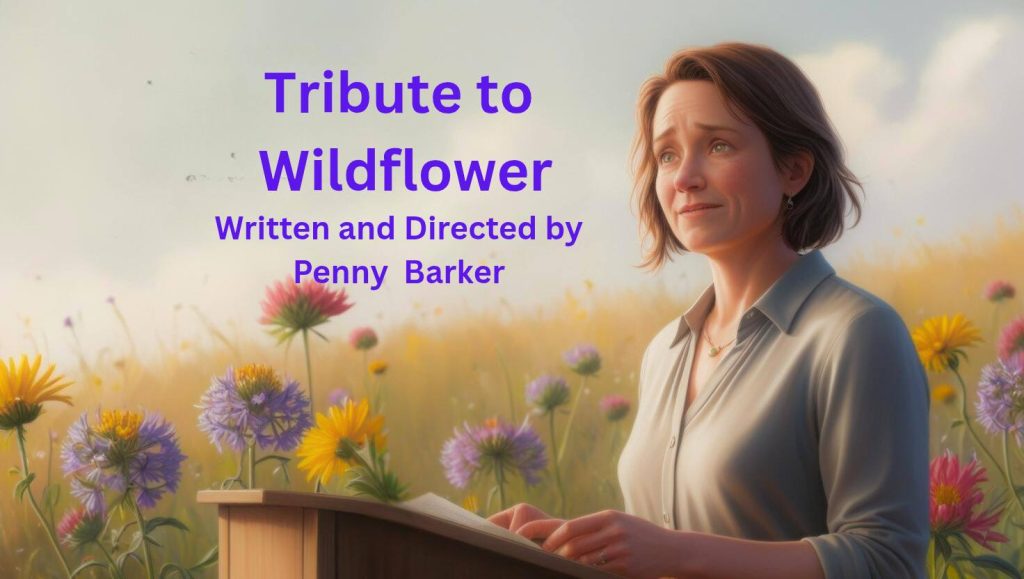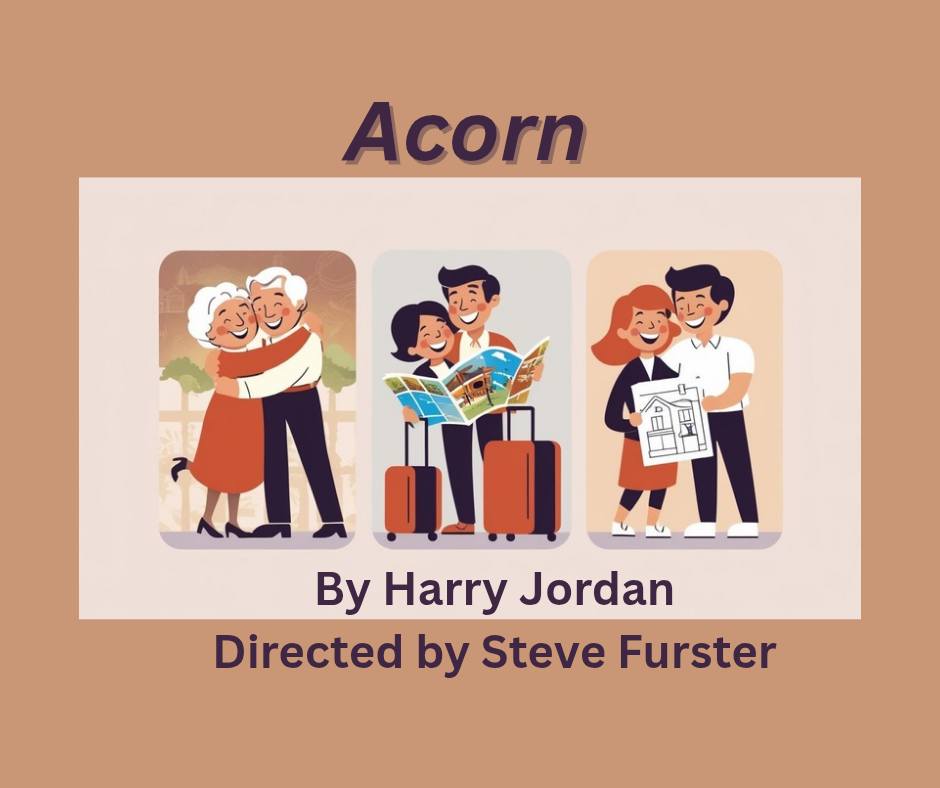Come Play by the Lake: ‘Tribute to Wildflower’ and ‘Acorn’

Tribute to Wildflower: How to Read a Bouquet
A dimly lit stage with lively jazz playing in the background welcomes the audience to a night of reflective and personal stories. To the right, a sign reads “Connie’s Flowers,” and in the center, a table with various props sets the scene of a charming flower shop. The story about to unfold is one of sisterhood, loss, perspective, and new beginnings. In Director Penny Barker’s Tribute to Wildflower, florist Fred, played by Jamie Hosking, forms an unexpected friendship with Julie, portrayed by actor Heather Barker, after the passing of her younger sister, Shannon. With Fred’s gentle guidance, we watch as Julie completes challenging tasks for Shannon’s celebration of life: selecting flowers, writing a eulogy, and revisiting memories of her sister she thought had been tucked away.
Even with minimal props, one outfit change, and two actors on stage, Director Barker and Technical Director Lisa Cruz ensure the play does not feel empty by creating realistic and well-developed characters within simple but logical settings. Thanks to the script’s naturalistic and conversational tone, Julie and Fred’s first meeting feels authentic. Their characters also seem familiar, and their conversations sound like a typical one you might overhear at a flower shop.
Heather Barker’s acting was incredibly emotional and remarkably captivating. As she delivered her eulogy in the final scene, the audience was completely entranced, hanging onto each word and every emotion. Even the humorous memories she shared in between the heavier or sadder ones did not break the spell she had cast, adding warmth and reliability while keeping the audience enraptured.
Shannon, though never seen on stage and never shown to the audience, is vividly yet fragmentarily described by Julie, sparking her presence in the minds of viewers. One of the most powerful storytelling tools was the use of a memory box and the many items it held. These helped create a tangible timeline, which made it easy for the audience to follow along, advanced the plot, and provided a convenient way to deepen Shannon’s character while also giving her a more tangible presence on stage.
Sunflowers for joy, daisies for new beginnings, lilies for rebirth—each flower was carefully chosen, not only for their beauty or fragrance but also for their meaning. The combination of Fred’s knowledge of the language of flowers and Julie’s memories weaves a bouquet of details that perfectly reflects Shannon’s personality and tells her story. In the end, Tribute to Wildflower offers more than just a floral arrangement; it tells the story of a grieving sister learning to let go of guilt and hold on to memory.
‘Tribute to Wildflower’ was part of the Come Play by the Lake One-Act Festival and was performed at Domino Theatre.

Acorn and the Generational Tree It Grew
When you reflect on your past conversations with people, what topic seems to come up most often? In my experience, it’s travel—the places they visited, the foods they ate, the people they met, and the memories they created along the way.
Acorn is a play that explores this theme through three couples from different generations of one family. The youngest pair is just starting their life together, reflecting on their ancestors’ travels and what the future may hold. Their parents, now empty-nesters, enjoy their newfound freedom and begin planning potential getaways for just the two of them. The oldest generation reminisces about their years of traveling together, cherishing the memories they made.
A performer who really stood out on stage was actor and playwright Harry Jordan. His performance felt tremendously genuine and he conveyed the story in a deeply personal and nostalgic manner. It stood out to me so much that when I got home after the play, I looked him up, and discovered that all the stories shared in the play are true stories about Jordan’s very own parents. His personal connection to the story radiated through his acting and made his presence so much more genuine and remarkable.
What emerges from this story is a waterfall of memories, stories, and experiences passed down through generations like a treasured heirloom. Director Steve Furster positions the three couples side-by-side on stage, each in different settings, telling the story of the oldest generation. Thanks to Lighting Designer Mya Steenbakkers and lighting done by Eric Bell, one by one, each couple is spotlighted—characters come to life—and when their story ends, the light fades, only to shine on the next pair as their story unfolds. This visual storytelling technique was executed beautifully and kept the narrative flowing smoothly.
Perhaps unintentionally, the play also highlights the vitality of digital media in preserving memories. As we develop better cameras and recording technology, future generations will discover new ways to capture the past and bring it into the present. The memories of those who came before us live on, enabling us to connect with family across distances and generations. The ability to preserve and pass down traditions that have been immortalized in digital media is an incredibly valuable gift.
Ultimately, Acorn reveals the significance of travel through the perspectives of three different generations, each shaped by the places they’ve visited and the memories they’ve made. It also quietly highlights the growing role of digital media in preserving legacies, traditions, bonds, and memories formed throughout time. Whether it’s through a photograph, a letter, or a video, there is a time, place, and person immortalized in what can seem like an insignificant piece of media. So next time you chat with someone about their travels, take a moment to consider how those stories and experiences have shaped who they are today—and how, by sharing them, they might shape future generations to come.
‘Acorn’ was part of the Come Play by the Lake One-Act Festival and was performed at Domino Theatre.
